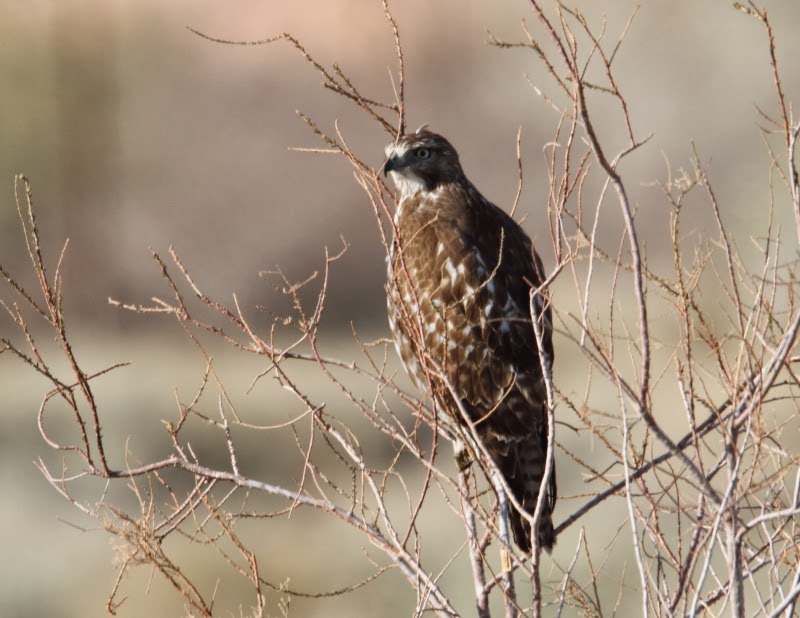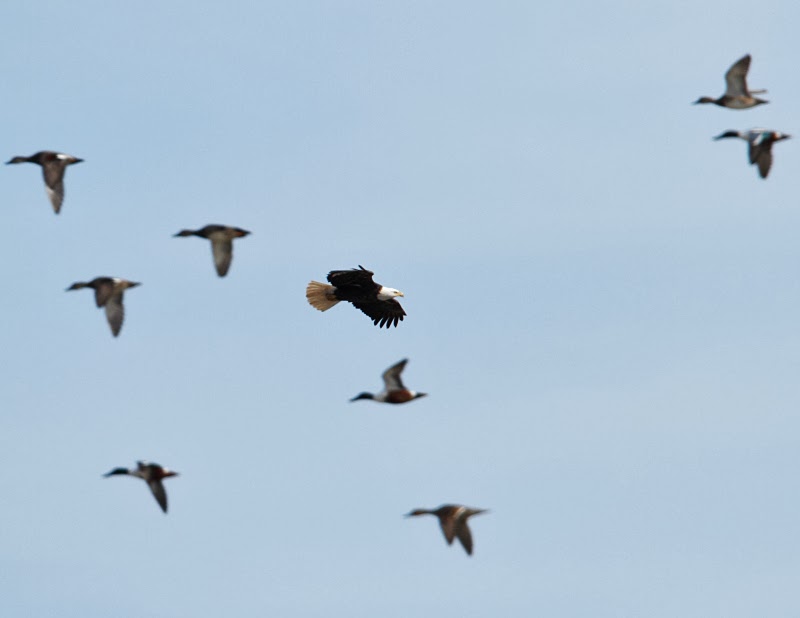I've been getting up at around 2am these past few weeks; seems like I only need about 5 hours of sleep, then a small nap or closing of the eyes in the late afternoon. I'm glad because it gives me time in the wee hours of the morning to do computer stuff like these posts. -- ..So yesterday I woke up, made some coffee in my Brew 'n Go coffeemaker -- I drink whatever is on sale, this time it was a Western Family (i.e., generic) roast @ $5.99 -- had breakfast, then headed back to the Overton Wildlife Management Area around 7:15 am. It was partly-cloudy and cool, around 45 degrees. I headed in the direction of Honeybee Pond, at the northern end of the wildlife area, and saw the Bald Eagle once again at its usual perch, on a tree overlooking a pond. The day before I got a shot looking east, with the desert mountains as a backdrop. This time it was looking west, with the redrock of the Valley of Fire State Park for a background --

Just prior to this, I'd noticed what looked to be a juvenile Red-tailed Hawk on a nearby tree --
He had a sharply-defined eye and iris, a sign of a juvenile, but he has lighter plumage on the front than you ordinarily see in Red-tails. Sheri Williamson of the Southern Arizona Bird Observatory (SABO) said you can't go far wrong if you ID any "unusual-looking" hawk you see as a Red-tail as chances are it is, and that's the case here....Then I noticed a hawk on the same tree that the Bald Eagle was in (who by this time had flown off), and took a shot of him --
Now this fellow has more of the "traditional" juvenile Red-tailed plumage, so I'm positive of the ID. He allowed me a few shots, then went to the pond the tree was overlooking --

And I mean he REALLY went to the pond; he was in it, on a small patch of land in the center, scanning things from a pond-level view. He held that position for a few minutes, then flew off. I saw the Bald Eagle again in the afternoon further south, in an area that I used to walk around while toting the 500 f/4 lens. These past few days I've been driving the Tundra on the dirt roads winding through the wildlife area, shooting from the truck using a Molar Bean Bag on the driver's side window where I rest the "BushHawk-less" 7D and 500 lens; the bean bag stabilizes it. The only downside to that is when vehicles occasionally roar past, spewing dust all over the place, and you can't close the window in time before the interior of the truck is covered in a fine layer of dirt. But what the heck -- it's a TRUCK, not a vehicle to be babied. Meanwhile, the wildlife area is full of the signs, and sounds, of spring -- singing Red-winged Blackbirds (hundreds of them), Marsh Wrens with their "mechanical-sounding" calls, Reds-tailed Hawks near their nests -- and the day ends seeing a Phainopepla and American Robin sharing the same mesquite bush. Here are some photos of the wildlife area, to give you some idea of the different habitat to be found there, and what the surrounding area looks like --

This is at one of the ponds looking west (the Bald Eagle tree is just off to the left, out of the picture) with the red rock of the Valley of Fire in the background, and the silva plant with its white mound of silva in the center.
This pond is further south than then one above. I've seen Spotted Towhee, Song Sparrow, Loggerhead Shrike, Yellow-Rumped Warblers, Northern Flickers, even a Brown Creeper here. And you can't beat those reflections...

This photo shows the area near the above pond, looking north to the Mormon Mountains in the distance. (Mormons created the town of Overton, as they did much of SE Nevada, and their influence is still strong; for instance, everything except for Lin's supermarket here in Overton is closed on Sunday.) After having lunch back at the trailer I headed to the southern section of the wildlife area, hoping to see the Vermilion Flycatcher once again, but suddenly a few big trucks appeared on the dirt road behind me, spewing dust, and stopped EXACTLY where I was to park to hike the road leading to the VFC. 14,000-plus acres, and they have to stop right there...It turned out they were part of a "dog retrieval" club, where they train dogs to retrieve the birds that had been shot --- excuse me, "harvested", in the terminology used by the Nevada Dept. of Wildlife workers; makes birds sound like a field of wheat! So the day out and about ended earlier than usual, but it was nevertheless full of
moments and scenes to remember...



















































